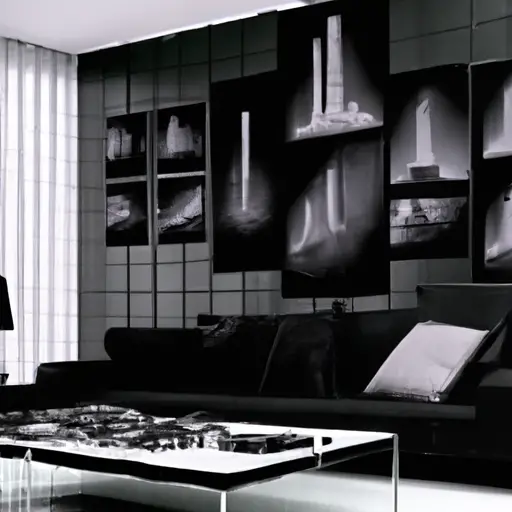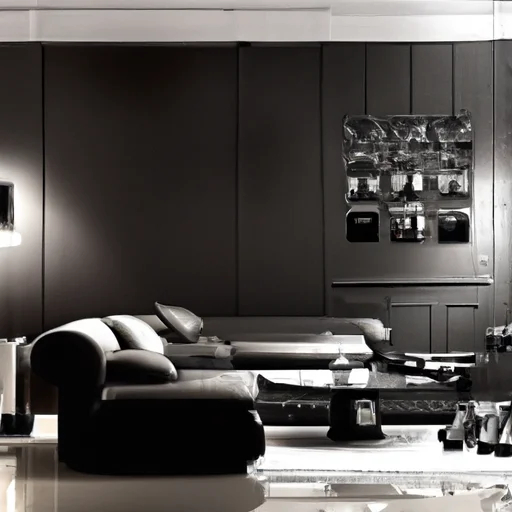Have you ever wondered about the effects of painting your walls black? Many people are hesitant to embrace this dramatic choice, fearing it will make their space feel small, gloomy, or claustrophobic. In this article, we explore the impact of painting walls black and discuss whether it’s truly a bad idea or an underappreciated design strategy. Let’s shed some light on the subject and discover the beauty and potential of black walls in our living spaces.
Is It Bad To Paint Walls Black?
Table of Contents
The Impact of Black Walls on Mood and Emotions
When considering the color scheme for our living spaces, we often focus on lighter and more neutral tones. However, painting our walls black can have a profound impact on our mood and emotions. In this article, we will explore the psychological effects of black walls, considerations for lighting, visual effects and aesthetics, room size and layout considerations, maintenance and upkeep, optimal combinations with lighting and contrast, the psychological impact on sleep, impact on energy efficiency, considerations for different rooms, and how black walls can reflect our personal style and make a statement.
Psychological Effects of Black Walls
The Perception of Space and Size
One of the most prominent psychological effects of black walls is their impact on the perception of space and size. While black walls can make a room feel smaller, they also create a sense of depth and intimacy. In larger rooms, black walls can make the space feel more cozy and inviting, while in smaller rooms, they can create a sense of expansiveness.
Mood and Ambiance
The color black is often associated with sophistication, elegance, and mystery. When used on walls, it can evoke a sense of drama and intensity, setting the tone for the entire space. Black walls can create a moody and atmospheric ambiance, perfect for intimate gatherings, reading nooks, or even a home office.
Emotional Response
Black walls can elicit a wide range of emotional responses. Some people may find them comforting and grounding, while others may feel a sense of heaviness or gloominess. It is important to consider our personal preferences and emotional sensitivities when deciding to paint our walls black. Understanding our emotional response to this color can help us create a space that aligns with our desired atmosphere.
Considerations for Lighting
When painting our walls black, lighting becomes a crucial consideration to ensure the space remains functional and welcoming. Both natural and artificial lighting play a significant role in complementing black walls.
Natural Light Considerations
Natural light can have a transformative effect on black walls. It is essential to consider how black walls absorb light and how it affects the overall ambiance of the room.
Absorption of Light
Black walls have a high light absorption rate. This means that they absorb more light than lighter-colored walls, which can make a room appear dimmer. When choosing to paint our walls black, we should be mindful of the amount of natural light the room receives throughout the day.
Natural Light Contrast
The contrast between natural light and black walls can create a striking visual effect. When sunlight streams through windows and illuminates black walls, it can create a beautiful play of light and shadows, adding depth and texture to the room.
Artificial Lighting Considerations
Artificial lighting is essential for creating a well-lit and inviting space when the natural light is limited. When choosing lighting fixtures for a room with black walls, there are a few considerations to keep in mind.
Type of Lighting Fixtures
The type of lighting fixtures we choose can significantly impact the overall ambiance of the room. Warm, soft light can help balance the darkness of the black walls and create a cozy and inviting atmosphere. Additionally, the placement of the fixtures can help enhance specific features or create focal points within the space.
Light Reflectance
Black walls have a low light reflectance, meaning they do not reflect as much light as lighter-colored walls. It is important to consider this when selecting lighting fixtures and bulbs. Using fixtures that direct light towards the ceiling or walls can help bounce and distribute light effectively, creating a more evenly lit space.

Visual Effects and Aesthetics
Black walls can have a powerful visual impact on a room’s aesthetics. They can create drama, accentuate features, and showcase art and décor.
Dramatic Impact
The boldness of black walls can bring a sense of drama and sophistication to any space. It can serve as a striking backdrop for furniture, artwork, and other decorative elements, elevating the overall visual impact of the room.
Accentuating Features
Black walls can highlight architectural features and unique details within a space. Whether it’s an exposed brick wall, a fireplace, or intricate molding, the contrast between the black walls and these elements can draw the eye and create a visually interesting focal point.
Showcasing Art and Décor
Black walls provide an excellent canvas for showcasing artwork, photographs, and decorative objects. Colors and textures tend to pop against the dark backdrop, allowing the pieces to become the center of attention and adding depth and sophistication to the overall aesthetic.
Creating Focal Points
Black walls can be strategically used to create focal points within a room. By painting a single wall in black or incorporating black panels or accents, we can draw attention to specific areas and create a sense of visual interest and depth.
Room Size and Layout Considerations
The size and layout of a room play a significant role in determining the impact of black walls.
Visual Perception of Space
Black walls have the ability to make a room feel larger or smaller depending on their application and the overall layout of the space.
Expansive Effects in Large Rooms
In larger rooms, black walls can help create a sense of coziness and intimacy. By visually bringing the walls closer together, black walls eliminate the feeling of vast emptiness and can make the space feel more inviting.
Cozy and Intimate Effects in Small Rooms
In smaller rooms, black walls can create a cozy and intimate atmosphere. The visual contraction of the space can help make it feel snug and charming, transforming it into a comforting haven.
Choosing Suitable Furniture and Accessories
When decorating a room with black walls, it is important to choose furniture and accessories that complement the color and enhance the overall aesthetic. Lighter-colored furniture can create a pleasing contrast against the darker walls, while strategically placed mirrors can reflect light and add a sense of depth to the space.
Maintenance and Upkeep
Before committing to black walls, it is essential to consider the maintenance and upkeep involved in maintaining their appearance.
Dust and Dirt Visibility
Black walls tend to show dust, dirt, and smudges more prominently than lighter-colored walls. Routine cleaning and dusting are necessary to keep the walls looking clean and well-maintained.
Scratches and Scuff Marks
Scratches and scuff marks can be more noticeable on black walls. It is important to take precautions when moving furniture or objects near the walls and to be mindful of any potential damage that may occur.
Repainting Challenges
Repainting black walls can be more challenging than lighter-colored walls. Achieving an even and consistent finish may require multiple coats of paint. Additionally, any imperfections or repairs may be more visible on a black surface.
Lighting and Contrast: Optimal Combinations
To enhance the impact of black walls, it is essential to consider lighting and contrast as complementary elements.
Creating Contrast with Light Textures
Introducing lighter textures through fabrics, rugs, or accessories can create a striking contrast against black walls. This contrast not only adds visual interest but also helps balance the overall aesthetic of the space.
White and Bright Accents
White and other bright accents can create a refreshing contrast against black walls. Utilizing white or bright-colored furniture, artwork, or textiles can create a vibrant and visually appealing atmosphere.
Balance with Wood or Other Natural Elements
Adding natural elements, such as wooden furniture or plants, can help provide balance when incorporating black walls into a room design. The warmth and organic textures of these elements can soften the overall aesthetic and create a harmonious blend of colors and materials.

Psychological Impact on Sleep
While black walls can create a dramatic and visually intriguing bedroom, it is important to consider their potential impact on sleep.
Promoting Sleep Disorders
For some individuals, the darkness and intensity of black walls may negatively impact sleep. The color black has been associated with feelings of depression, anxiety, and restlessness. It is crucial to assess our personal response to black and consider the potential impact on our ability to fall asleep and the quality of our sleep.
Difficulty Falling Asleep
The depth and darkness of black walls may make it harder for some individuals to relax and fall asleep. It is important to ensure that the overall bedroom environment remains calming and conducive to sleep.
Sleep Quality
Black walls can create a cocoon-like atmosphere that promotes a sense of security and comfort. However, it is essential to maintain a balance between the intimate ambiance of the room and the need for a restful sleep environment.
Personal Preferences
When it comes to bedroom design, personal preferences play a significant role. Some individuals thrive in a dark and cozy environment, while others may find it overwhelming. Understanding our personal preferences and considerations can help us make an informed decision about incorporating black walls into our bedrooms.
Impact on Energy Efficiency
One aspect often overlooked when considering black walls is their impact on energy efficiency.
Absorption of Light and Heat
Black walls absorb more light and heat compared to lighter-colored walls. In regions with warmer climates and long hours of sunlight, this can result in increased indoor temperatures, potentially leading to higher cooling costs.
Cooling Costs
To counteract the potential increase in cooling costs, it is important to ensure proper insulation and consider energy-efficient cooling solutions, such as window treatments and ceiling fans. Maintaining a comfortable indoor temperature can help offset any additional cooling expenses.
Insulation Considerations
Proper insulation is key when dealing with black walls. Ensuring the space is well-insulated can help minimize heat transfer and maintain a more stable indoor temperature. This is especially important in rooms with black walls, as they tend to absorb and retain heat more readily.

Considerations for Different Rooms
Each room in our home has its own unique characteristics and functions. When considering black walls, it is important to take into account the specific considerations for different rooms.
Living Rooms
In living rooms, black walls can create a sophisticated and intimate atmosphere. However, it is important to balance the darkness with lighter-colored furniture and accents to prevent the space from feeling overwhelming.
Bedrooms
Black walls in bedrooms can create a calming and cocoon-like environment. It is crucial to strike a balance between the intimacy of the color and the need for a restful sleep environment.
Kitchens
While black walls can add drama and elegance to a kitchen, they can also make the space feel smaller and closed off. Careful consideration should be given to lighting and contrast to maintain a functional and inviting kitchen space.
Bathrooms
Black walls in bathrooms can create a luxurious and spa-like atmosphere. However, it is important to ensure proper lighting and ventilation to prevent the space from feeling dark and unwelcoming.
Personal Style and Statement
When deciding to paint our walls black, we have the opportunity to make a bold and unique style statement.
Bold and Dramatic Look
Black walls offer an opportunity to create a bold and dramatic look. Whether we pair them with contrasting features or incorporate other dark elements into the space, our personal style can shine through by embracing the intensity of black.
Unique and Expressive Environment
Black walls allow for a unique and expressive environment. By personalizing the space with artwork, personal collections, and distinctive décor, we can create a visually stunning and meaningful space that reflects our individuality.
Coordinating Color Schemes
Black walls can be paired with a wide range of colors to create various aesthetics. From vibrant and playful tones to more subdued and monochromatic palettes, the versatility of black allows us to coordinate color schemes that align with our personal style and desired atmosphere.
In conclusion, while painting our walls black may be unconventional, it can have a profound impact on the mood and emotions within our living spaces. Understanding the psychological effects, considerations for lighting and contrast, maintenance and upkeep, as well as the impact on energy efficiency, can help us make an informed decision about incorporating black walls into our homes. By considering personal preferences, room size and layout, and the overall style we want to convey, we can create a space that is visually striking, expressive, and uniquely our own.


